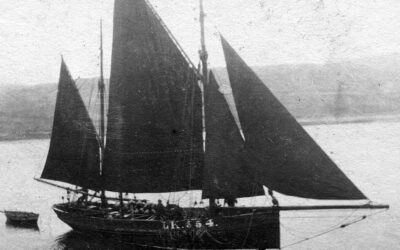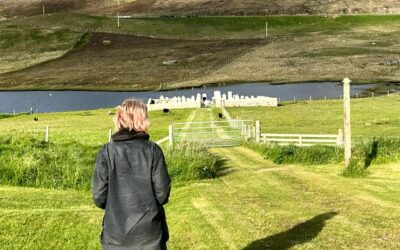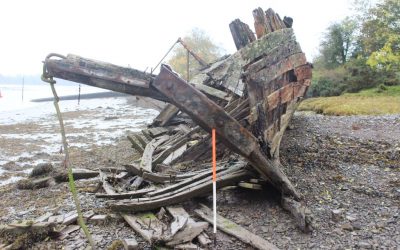Candace: The Life of a Lowestoft Sailing Drifter (1888–1919)
In a quiet inlet of Southladie Voe, West Sandwick, Yell (Shetland), lies the remains of an old wooden wreck. Enough survives to identify her as a probable Class 1 sailing drifter, though her design differs from the more familiar Zulus and Fifies of the Scottish...
A Walk of Discovery: North Yell, Shetland
The stunning beach at Sands of Breckon is a magnet in North Yell for locals and visitors alike – but did you know that by taking a short walk around the headland you will discover a rich archaeological landscape of settlement, burials and historic structures. Our...
A Walk of Discovery: Ness of Duncansby, Caithness
Just east of John O’ Groats at a place called Robert’s Haven, you can see fragments of drystone walls and dark coloured soils full of pottery, shell, and fish bone eroding out of the dunes. Thanks to an archaeological investigation by James Barrett in the early 1990s,...
A maritime landscape revealed at low tide in Borosdale Bay
Going through the records after a survey is always a pleasure and is often when the true significance of a place is revealed. Borosdale Bay near Rodel on the Isle of Harris is a great example. The falling tide uncovered an array of stone structures across the...
Defending Scotland’s coast: WWII radar stations
During WW II Scotland’s coast was defended from attacks from the air and sea. Pill boxes, lines of concrete tank cubes and anti-glider posts were part of the coastal crust to prevent beach landings of planes and vessels with tanks. The famous Churchill Barriers...
Fairway to the Sea: Celebrating women’s golfing history at Scotland’s oldest golf course
Celebrating the AIG Women’s Open Golf Championship in St Andrew’s. Delving into the important archaeological heritage of the Old Course, exploring the history of the women’s game and highlighting the impact of climate change to these important historical coastal sites.
Taking to the skies to explore the Moray Firth fish traps
In April we kicked off our new Coastal Zone Assessment Survey of the south Moray Firth and Aberdeenshire coasts. Over two trips with local volunteers from NoSAS, we walked much of the coastline from Inverness to Culbin Forest. Along this stretch of coast, the low tide...
Sgeir nam Portan: a prehistoric coastal site at risk in South Uist – a site monitoring diary by Simon Davies
Site 8915 on the SCAPE register is Sgeir nam Portan. Derived from the Gaelic sgeir, originally Old Norse rocks exposed as tides drop (the same derivation as Skerry), and portan (an alternative version of partan), small edible sea-crab of a black colour. Skerry of the...
A walk of discovery in my own backyard
Earlier this year I went for a walk along a local stretch of the Fife coast, starting at the famous St Monans salt works and ending at Pittenweem. This must be one of the busiest sections of the Fife Coastal Path, and there are numerous recorded coastal heritage sites...
Handsel Monday and the Wemyss Caves
Today is Handsel Monday!
Handsel Monday was once the main and sometimes only holiday of the year in lowland Scotland. Rural workers got a day off and received small gifts or handsels from their employers.
The curious Fauna, Kirkcudbright Bay
Why on earth would you cut hundreds of small circular holes into the hull of your boat? Only to painstakingly plug them all again? That was a question we pondered in 2015 when we first visited Gibbhill in Kirkcudbright Bay and saw this old wooden trawler resting on...
From Scotland to Tanzania
Tropical temperatures, mangroves and coral reefs: at first glance, it might be hard to see similarities between the shores of Scotland and the Indian Ocean coastline. However, our recent trip to the island of Kilwa Kisiwani, on Tanzania’s southeast coast with a team...
From stones to bones: studying Scottish coastal change with SCAPE and Dynamic Coast
Eroding coastal heritage sites documented by volunteers through SCHARP are valuable because they are based on field observations so are true records of what is actually happening at the coast. This means we can use them to test or validate models of coastal...
Mesolithic oaks to Mulberry Harbours – 8,000 years of history along the Solway Firth
One of the joys of coastal archaeology is that it encompasses sites of all types and periods. A recent recording visit to three stretches of the Solway coast with the Coastwise Project and local volunteers took us from remnants of Mesolithic forest to secretive D-Day...
Revealing the post-medieval landscape of Higgins Neuk
“What you think you will find is not what you find. That ought to be an axiom in archaeology.” (Ben Okri, FT Magazine October 19, 2018) After decades of research had pinpointed Higgins Neuk as the likely location of a royal dockyard built by James 4th , hard evidence...















